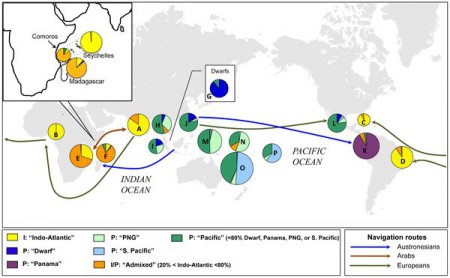The picture really is worth a thousand words, but if you still want the words…
Nibbles: Cranberry pests, Productivity, Resistance breeding, Jackfruit, Oca etc, Millets, Root crops, Semen cryo
- Guess what. Cranberry pests prefer certain varieties.
- If you can’t measure it, you can’t improve it. Estimating yield of food crops grown by smallholder farmers from IFPRI.
- CIAT first CG centre to publish peer-reviewed video, on resistance selection. In other news, there are peer-reviewed videos?
- CFTF draws our attention to Jackfruit – Forgotten Kalpavriksha, “a common trope”.
- $3.4 million worth of good news for food security and diversity in the Andes. “Small Andean tuber crops” involved.
- Minor millets star in new film shared by Bioversity.
- Want the Philippines to be self-sufficient in rice? Eat rootcrops. IRRI unavailable for comment.
- Way more than any sensible person will ever want to know about duck and goose semen.
Nibbles: Median strips, Vitamin A, Mapping in Kenya, Chaffey, Small farms, Rennell Island coconuts, Sweet potato breeding, Acacia nomenclature, Crop models, Pulque, Fruits
- Planting roadsides with natives, including crop wild relatives. And here comes the database.
- Orange Maize: The Movies.
- VirtualKenya really here. Mother-in-law beside herself.
- Plant Cuttings is out. And all of a sudden I’m in a much better place.
- Small is beautiful, farm edition. And as chance would have it, coffee farm edition. And urban edition.
- Dispute at iconic coconut plantation resolved. Apparently there are some really unique varieties there.
- I say boniato. For the first and last time.
- Acacia on the brink. Easy, tiger. The name, not the genus.
- We’re going to need a better model.
- Pulque comes back. Never knew it had gone away.
- Domesticating fruit trees in Kenya. Something for VirtualKenya?
Nibbles: Cryo, Tree diversity, Agroforestry, Seed industry, Trigonella, Ancient MesoAmerica, Niche models
- CIP’s high-tech genebank.
- “The project’s eventual aim is to plant several thousand trees at sites across Perthshire to act as a ‘living gene bank.'” What, because normally genebanks are dead?
- Millennium Seed Bank joins ICRAF’s BusyTrees thing. Which you can follow in about a million different social networking ways.
- Conservation Magazine does a number on crop improvement. Wait, what? Conservation Magazine? Yep, and with teaching resources.
- Fenugreek, barkeep, and make it a double.
- Ancient chocolate and corn routes.
- What species distribution models do you like?
Nibbles: Seed savers, Lemons, Assam Rice, Striga control, Amaranth, Bearded pigs, Banana, Early nutrition
- Seed savers: everyone’s got an angle, from Seeds of Hope and Change to Seed Bank Bingo.
- Italian lemons enjoying a renaissance. In California, natch.
- India registers Assam farmers’ traditional rice varieties. In other news, rice water “is also used as shampoo, according to community elders”.
- US$9 million to “implement and evaluate four approaches” to controlling Striga in Africa. One day we’ll know.
- Denver Botanic Gardens does amaranth.
- Evolution of bearded pigs. Good to know. Good to eat?
- Bioversity banana team guest blogs at Annals of Botany. But surely they have a blog of their own. No, wait…
- Agriculture is bad for your health.
